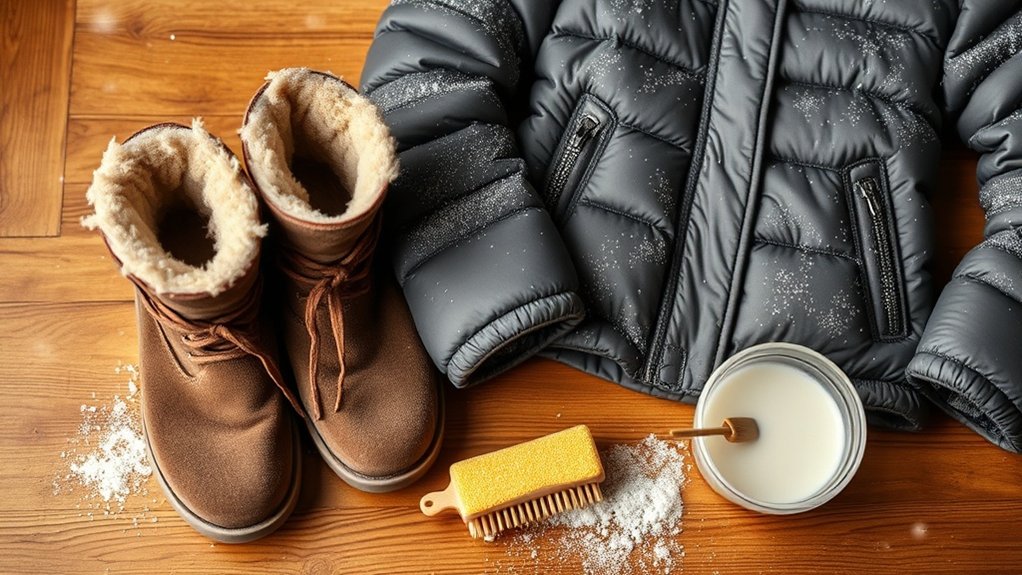How to Clean Ugg Boots, Puffer Jackets and Other Tricky Winter Items
Cleaning Ugg boots and puffer jackets requires care to preserve their unique materials. For puffer jackets, check the label and wash on a gentle cycle with down-specific detergent. Ugg boots demand gentle cleaning with specialized shampoos and spot-cleaning tools. For other winter garments, tackle stains promptly with a mild detergent. It’s essential to maintain proper storage practices to extend their lifespan. By understanding these techniques, winter wear can remain clean and functional throughout the season. More insights await.
Cleaning Puffer Jackets: A Step-by-Step Guide
Cleaning puffer jackets can seem intimidating, but with the right approach, it becomes a manageable task.
Puffer jacket care begins with checking the manufacturer’s label for specific washing techniques. For jackets filled with down, using a down-specific detergent is essential to maintain loft. Spot-cleaning minor stains prolongs the jacket’s life, while a gentle cycle in cold water reduces wear.
To prevent damage, avoid machines with centre agitators and confirm all zippers are closed.
After washing, drying can be done by hanging or using a dryer on low heat with tennis balls to restore fluffiness, confirming the jacket remains warm and functional.
Essential Tips for Maintaining Ugg Boots and Slippers
Maintaining ugg boots and slippers is essential for preserving their comfort and longevity. Seasonal care involves keeping these items clean and dry, protecting them from moisture to prevent damage.
Material considerations are vital; genuine leather and sheepskin demand gentle cleaning methods, such as spot-cleaning with a suede brush or dry cloth. For deeper cleaning, using specific ugg boot or sheep wool-skin shampoo guarantees the fibers remain intact.
Additionally, stuffing boots while drying helps maintain their shape, while regular vacuuming restores the wool pile. By following these tips, owners can extend the life and appearance of their beloved winter footwear.
Effective Methods for Spot-Cleaning Winter Garments
Spot-cleaning winter garments effectively preserves their appearance and extends their lifespan, especially for items made from delicate materials.
Employing spot cleaning techniques can efficiently tackle minor stains without compromising the fabric’s integrity.
- Blot, don’t rub: Gently dab the stained area with a clean cloth to absorb excess moisture and lift the stain.
- Use appropriate cleaners: Select a mild detergent or specialized stain removal product suitable for the fabric type.
- Test first: Always perform a patch test on a hidden area to verify there is no discoloration before applying any cleaning solution.
Recommended Products for Specialized Fabric Care
In relation to caring for specialized fabrics, selecting the right products is vital for preserving their unique qualities and longevity.
For puffer jackets, down-specific detergents are highly recommended to maintain insulation while avoiding damage during washing.
Ugg boots and sheepskin slippers benefit from specialized shampoos designed to clean without stripping natural oils.
Additionally, a suede brush and gum eraser effectively tackle surface dirt on suede materials.
When choosing fabric care products, consider gentle, eco-friendly options to guarantee both garment preservation and environmental responsibility.
These product recommendations are fundamental for maintaining the integrity of winter clothing items.
Best Practices for Storing Winter Clothing Properly
Proper storage of winter clothing is essential for ensuring longevity and maintaining their condition for the next season. Implementing effective seasonal rotation and focusing on fabric preservation can greatly enhance the lifespan of winter garments.
- Clean Before Storing: Always wash or dry clean items to remove stains and odors, preventing fabric deterioration.
- Use Appropriate Hangers: Store heavier items like coats on sturdy hangers to maintain shape, while lighter garments can be folded.
- Choose a Cool, Dry Space: Keep clothing in a temperature-controlled area, avoiding dampness to deter mold and mildew.
Following these practices will protect winter clothing for future wear.







